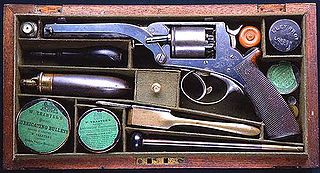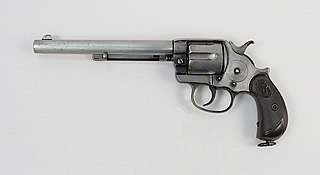
A revolver is a repeating handgun that has at least one barrel and uses a revolving cylinder containing multiple chambers for firing. Because most revolver models hold up to six cartridges, before needing to be reloaded, revolvers are commonly called six shooters.

Colt's Manufacturing Company, LLC is an American firearms manufacturer, founded in 1855 by Samuel Colt and now a subsidiary of Czech holding company Colt CZ Group. It is the successor corporation to Colt's earlier firearms-making efforts, which started in 1836. Colt is known for the engineering, production, and marketing of firearms, most especially between the 1850s and World War I, when it was a dominating force in its industry and a seminal influence on manufacturing technology. Colt's earliest designs played a major role in the popularization of the revolver and the shift away from single-shot pistols. Although Samuel Colt did not invent the revolver concept, his designs resulted in the first very successful model.

The Colt Single Action Army is a single-action revolver handgun. It was designed for the U.S. government service revolver trials of 1872 by Colt's Patent Firearms Manufacturing Company and was adopted as the standard-issued pistol of the U.S. Army from 1873 until 1892.

The pepper-box revolver or simply pepperbox is a multiple-barrel firearm, mostly in the form of a handgun, that has three or more gun barrels in a coaxially revolving mechanism. Each barrel holds a single shot, and the shooter can manually rotate the whole barrel assembly to sequentially index each barrel into alignment with the lock or hammer, similar to rotation of a revolver's cylinder.

Ethan Allen was a major American arms maker from Massachusetts. He is unrelated to the revolutionary Ethan Allen. His first firearm, the "Pocket rifle" was developed in 1836, and his first patent was granted in 1837.

The LeMat revolver was a .42 or .36 caliber cap & ball black powder revolver invented by Jean Alexandre LeMat of France, which featured an unusual secondary 16 to 20 gauge smooth-bore barrel capable of firing buckshot. It saw service with the armed forces of the Confederate States of America during the American Civil War of 1861–1865 and the Army of the Government of National Defense during the Franco-Prussian War.
Robert Adams (1810–1870) was a 19th-century British gunsmith who patented the first successful double-action revolver in 1851. His revolvers were used during the Crimean War, the Indian Mutiny, the American Civil War, and the Anglo-Zulu War.

Kerr's Patent Revolver was an unusual 5-shot single-action revolver manufactured from 1859 to 1866 by the London Armoury Company. It was used by Confederate cavalrymen during the U.S. Civil War. Seven of these revolvers were held by the New Zealand Colonial Defence Force in 1863 and were issued to the famous Forest Rangers at the start of the campaign to push Māori rebels out of the Auckland province. It is easily recognized by its side-mounted hammer.

H&R 1871, LLC, or more commonly known as Harrington & Richardson, is an American brand of firearms and a subsidiary of JJE Capital Holdings. H&R ceased independent production February 27, 2015.

The Colt Army Model 1860 is a cap & ball .44-caliber single-action revolver used during the American Civil War made by Colt's Manufacturing Company. It was used as a side arm by cavalry, infantry, artillery troops, and naval forces.

The Beaumont–Adams revolver is a black powder, double-action, percussion revolver. Originally adopted by the British Army in .442 calibre in 1856, it was replaced in British service in 1880 by the .476 calibre Enfield Mk I revolver.

The Colt Model 1861 Navy cap & ball .36-caliber revolver was a six-shot, single-action percussion weapon produced by Colt's Manufacturing Company from 1861 until 1873. It incorporated the "creeping" or ratchet loading lever and round barrel of the .44-caliber Army Model of 1860 but had a barrel one half inch shorter, at 7.5 inches. Total production was 38,000 revolvers.

The Remington-Beals Model Revolvers along with subsequent models and variations were percussion revolvers manufactured by Eliphalet Remington & Sons in .31 (Pocket) .36 (Navy) or .44 (Army) caliber, used during the American Civil War, and was the beginning of a successful line of medium and large frame pistols. They are commonly, though inaccurately, referred to as the Model 1858 due to the patent markings on its New Model barrels, "PATENTED SEPT. 14, 1858/E. REMINGTON & SONS, ILION, NEW YORK, U.S.A./NEW MODEL."; although wide scale production did not start until 1861.

A handgun is a firearm designed to be usable with only one hand. It is distinguished from a long gun which needs to be held by both hands and braced against the shoulder. Hand guns have a shorter range compared to long guns. The two most common types of handguns are revolvers and semi-automatic pistols, although other types such as derringers and machine pistols also see infrequent usage.

The Colt Paterson revolver was the first commercial repeating firearm employing a revolving cylinder with multiple chambers aligned with a single, stationary barrel. Its design was patented by Samuel Colt on February 25, 1836, in the United States, England and France, and it derived its name from being produced in Paterson, New Jersey. Initially this 5 shot revolver was produced in .28 caliber, with a .36 caliber model following a year later. As originally designed and produced, no loading lever was included with the revolver; a user had to partially disassemble the revolver to re-load it. Starting in 1839, however, a reloading lever and a capping window were incorporated into the design, allowing reloading without disassembly. This loading lever and capping window design change was also incorporated after the fact into most Colt Paterson revolvers that had been produced from 1836 until 1839. Unlike later revolvers, a folding trigger was incorporated into the Colt Paterson. The trigger became visible only upon cocking the hammer.

The Colt Revolving Belt Pistol or Navy Pistol, sometimes erroneously referred to as "Colt Revolving Belt Pistol of Naval Caliber" or "of Navy Caliber", is a cap and ball revolver that was designed by Samuel Colt between 1847 and 1850. Colt first referred to this Revolver as the Ranger Size model, and then Revolving Belt, but the designation "Navy" quickly took over.

The family of Colt Pocket Percussion Revolvers evolved from the earlier commercial revolvers marketed by the Patent Arms Manufacturing Company of Paterson, N.J. The smaller versions of Colt's first revolvers are also called "Baby Patersons" by collectors and were produced first in .28 to .31 caliber, and later in .36 caliber, by means of rebating the frame and adding a "step" to the cylinder to increase diameter. The .31 caliber carried over into Samuel Colt's second venture in the arms trade in the form of the "Baby Dragoon"-a small revolver developed in 1847–48. The "Baby Dragoon" was in parallel development with Colt's other revolvers and, by 1850, it had evolved into the "Colt's Revolving Pocket Pistol" that collectors now name "The Pocket Model of 1849". It is a smaller brother of the more famous "Colt's Revolving Belt Pistol of Naval Caliber" introduced the same year and commonly designated by collectors as the "1851 Navy Model". In 1855 Colt introduced another pocket percussion revolver, the Colt 1855 "Sidehammer", designed alongside engineer Elisha K. Root.

The Tranter revolver was a double-action cap & ball revolver invented around 1856 by English firearms designer William Tranter (1816–1890). Originally operated with a special dual-trigger mechanism later models employed a single-trigger mechanism much the same as that found in the contemporary Beaumont–Adams revolver.

The Colt M1878 is a double-action revolver that was manufactured by Colt's Manufacturing Company from 1878 until 1907. It is often referred to as the "Frontier" or the "Double Action Army" revolver. A total of 51,210 Model 1878 revolvers were manufactured, including 4,600 for the US Ordnance Department. These are known as the "Philippine" or "Alaskan" models.

The Colt Model 1871–72 Open Top is a metallic cartridge rear-loading .44-caliber revolver introduced in 1872 by the Colt's Patent Fire Arms Manufacturing Company. This handgun was developed following two patents, the first one in 1871 and the second one in 1872, it is estimated that the production span lies primarily between February 1872 and June 1873. There is therefore still some confusion when naming it. It is sometimes named Colt Model 1871 or Colt Model 1872 but at this time the most common accepted names are Colt Model 1871–72 Open Top, Colt Model 1871–72 or simply Colt Open Top.
























